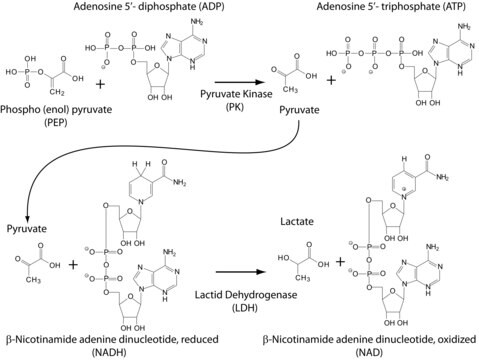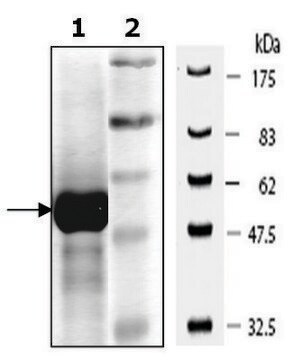MAK072
Pyruvate Kinase Activity Assay Kit
sufficient for 100 colorimetric or fluorometric tests
About This Item
Empfohlene Produkte
Verwendung
sufficient for 100 colorimetric or fluorometric tests
Nachweisverfahren
colorimetric
fluorometric
Relevante Krankheit(en)
hematological disorder; cancer
Lagertemp.
−20°C
Verwandte Kategorien
Allgemeine Beschreibung
The Pyruvate Kinase Activity Assay Kit provides a simple and direct procedure for measuring pyruvate kinase activity in a variety of biological samples. Pyruvate concentration is determined by a coupled enzyme assay, which results in a colorimetric (570 nm)/ fluorometric (λex = 535/λem = 587 nm) product, proportional to the pyruvate present. One unit of pyruvate kinase is the amount of enzyme that will transfer a phosphate group from PEP to ADP to generate 1.0 μmole of pyruvate per minute at 25 °C.
Anwendung
Eignung
Prinzip
Ersetzt durch
Signalwort
Danger
H-Sätze
Gefahreneinstufungen
Aquatic Chronic 3 - Resp. Sens. 1 - Skin Sens. 1
Lagerklassenschlüssel
10 - Combustible liquids
WGK
WGK 3
Analysenzertifikate (COA)
Suchen Sie nach Analysenzertifikate (COA), indem Sie die Lot-/Chargennummer des Produkts eingeben. Lot- und Chargennummern sind auf dem Produktetikett hinter den Wörtern ‘Lot’ oder ‘Batch’ (Lot oder Charge) zu finden.
Besitzen Sie dieses Produkt bereits?
In der Dokumentenbibliothek finden Sie die Dokumentation zu den Produkten, die Sie kürzlich erworben haben.
Kunden haben sich ebenfalls angesehen
Artikel
We presents an article about the Warburg effect, and how it is the enhanced conversion of glucose to lactate observed in tumor cells, even in the presence of normal levels of oxygen. Otto Heinrich Warburg demonstrated in 1924 that cancer cells show an increased dependence on glycolysis to meet their energy needs, regardless of whether they were well-oxygenated or not.
Unser Team von Wissenschaftlern verfügt über Erfahrung in allen Forschungsbereichen einschließlich Life Science, Materialwissenschaften, chemischer Synthese, Chromatographie, Analytik und vielen mehr..
Setzen Sie sich mit dem technischen Dienst in Verbindung.






